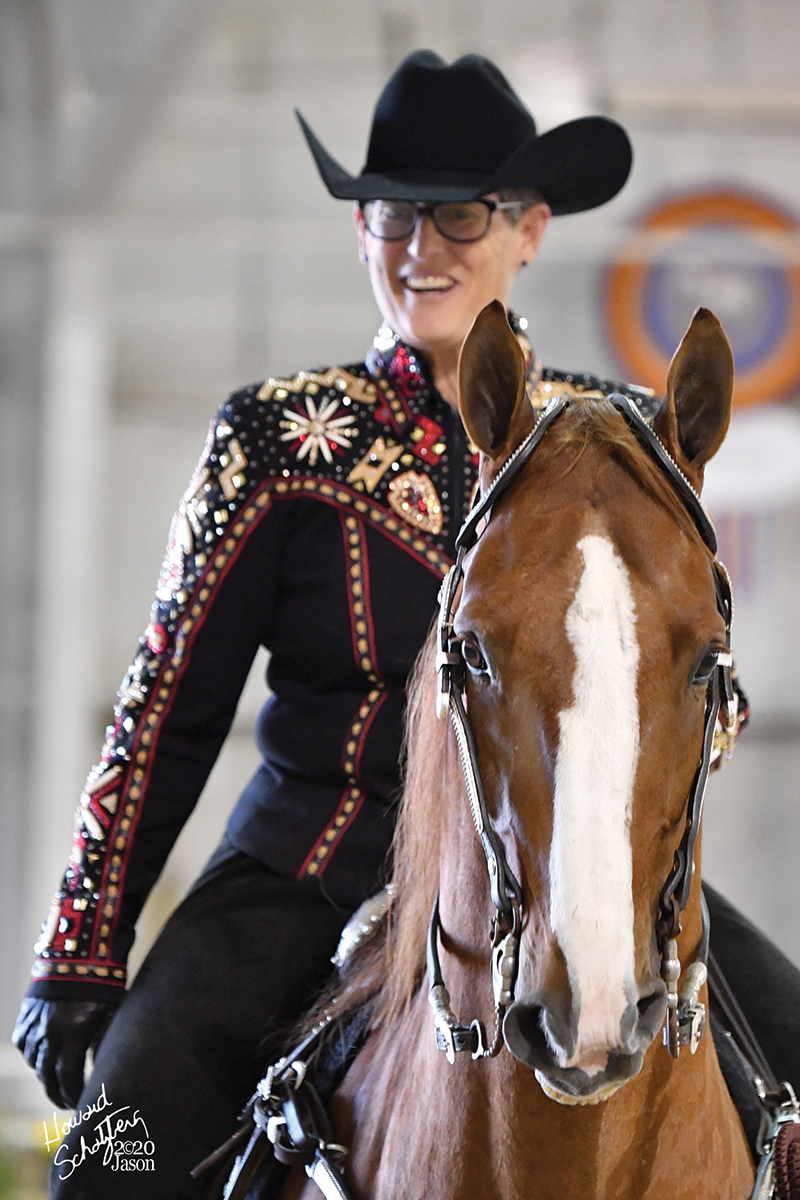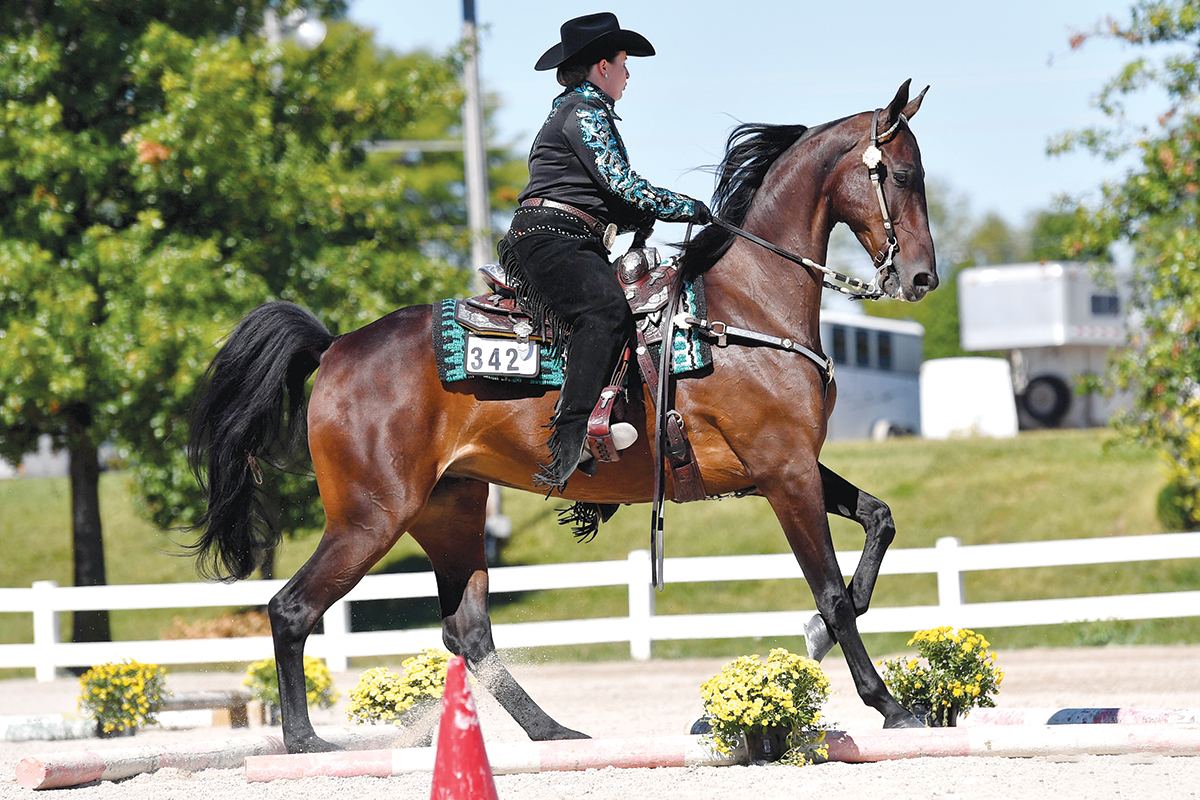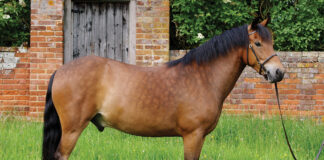Years ago, if you attended a Saddlebred horse show, you could expect to see high-stepping, animated horses shown in saddle seat and fine harness classes and not much else. And while the beauty and excitement of the saddle seat show ring is still a beloved part of the experience for Saddlebred enthusiasts, this breed is not just a one-trick pony. The class lists are changing to show that American Saddlebreds get western.

A Bright Future for the American Saddlebred
Saddlebred owners have long been taking their horses outside of the confines of the breed-specific shows to compete in everything from combined driving and endurance riding to eventing and dressage. The western pleasure and hunter pleasure divisions have become so popular that they are now a fixture at most Saddlebred shows, including the World’s Championship Horse Show held annually at the Kentucky State Fair in Louisville, Ky.
For 2021, the breed is preparing to add another new discipline to its official rule book: the ranch horse division. If approved by the United States Equestrian Federation, the ranch horse division for Saddlebreds will include ranch riding, ranch trail, ranch rail pleasure, and ranchmanship classes.
American Saddlebreds Go West
Janet Thompson is an American Saddlebred owner and enthusiast in Missouri. She was introduced to Saddlebreds at a young age and started out riding saddle seat, but she soon branched out into other disciplines. She found that her Saddlebreds were able to do it all.
“One of the Saddlebreds that I showed eventually became my eventer, but first he was my working western horse,” says Thompson. “The place where I boarded him had cattle, and every summer they ran about 200 steers. Part of my board was to check fences and check the cattle, so he had to be able to ground tie, and I had to be able to rope off of him.”

Thompson is a member of the American Saddlebred Versatility Association, also known as VERSA, a charter club that promotes Saddlebreds in sport and working disciplines. VERSA has been instrumental in making the ranch horse division a reality.
“One of our board members, Carol Jones, has had a lot of success with Saddlebreds in the working western division,” says Thompson. “She raised the notion that VERSA might want to get the ranch division started for Saddlebreds, and that really fit a lot of what we were interested in. A lot of owners or potential owners and riders want to get back to a lower-key, lower-cost discipline. You don’t have to spend thousands of dollars on a saddle that drips with silver or show clothes that are sparkly. You can just concentrate on what you can create with your horse.”
The ranch horse division includes rail classes, patterns, and trail obstacles. These classes show off some of the characteristics that let American Saddlebreds get western. And that’s exactly what enthusiasts like Thompson love about their horses.
“Right now I’m showing my horse The Kansas City Chief,” she says. “His barn name is King. He really enjoys this division; the trail stuff is kind of his forte. To me, he looks like the division. He’s really pretty and flashy, but he’s a bigger, stouter, old-fashioned kind of Saddlebred, and I think he looks the part.”
While the division was not yet official for the 2020 show season, a few Saddlebred-oriented shows offered ranch classes, and debuted at the Un-Fair Horse Show in Iowa, named in honor of the many state fair cancellations in 2020. Thompson says the response was overwhelmingly positive from participants and spectators alike.
“Sure, it was a competition, but I’ve never seen so many smiles on people’s faces as when they competed in these classes,” says Thompson. “Everybody was happy! At both shows we had an amazing audience. Everyone came over and watched because it was so different.”
The Everything Horse
Ginny Norton got hooked on Saddlebreds from a young age. Like Thompson, she found that whatever equestrian sport she wanted to pursue, the American Saddlebred—her favorite breed—was up to the task. She’s competed in saddle seat, hunters, and western pleasure in the past, and now does working western with her Saddlebred mare, Walterway’s Latest News, known as Kenzie.
“Kenzie is my heart horse for sure,” says Norton. “In the working western, we have a trail course and a rail portion, so you have to be good on the trail and a pretty mover on the rail. She is probably the coolest horse I’ve ever ridden through a trail course. She makes me look good. If you point her at an obstacle, she’ll get you over it and not touch it. She’s really light and elegant on her feet.”
Norton and Kenzie compete on their local open circuit against all breeds in the ranch horse division, and while Kenzie is often the only Saddlebred in the class, she is always up to the task.

“She does all the maneuvers,” says Norton. “She’ll stand and move off my leg. She’ll go through gates and come back really nicely. She’s reliable when it comes to a pattern.”
Forming a true partnership between horse and rider is one of the joys of the working western and ranch horse classes, and that’s something that both Saddlebreds and their owners enjoy.
“Saddlebreds’ willing attitude and athleticism are the keys that make them really neat working western horses,” says Norton. “I’ve found that they’re really willing to please. They’re just waiting for me to say, ‘this is the path.’ You can almost feel them being proud of themselves and really enjoying that pat on the neck when you say, ‘Yes, that is exactly what I wanted!’”
Norton adds that a horse that shows in the trail course has to be athletic and talented with their feet to complete the course.
“Saddlebreds fit the bill for that,” she says. “Our Saddlebreds generally have a little more animation in their trot, and that’s one of my favorite things. When Kenzie is trotting over an obstacle or even loping, she has a little more knee action, and to me it looks really elegant and pretty as she picks her way through a trail course.”
Norton calls Kenzie her “everything horse.”
“I’ve shown her in just about every discipline and she’s done it all willingly and very successfully,” she continues. “I think that whatever you find for your Saddlebred to do that’s fun for you, they’re a willing partner, and that’s pretty cool to me.”
This article about western American Saddlebreds appeared in the January/February 2021 issue of Horse Illustrated magazine. Click here to subscribe!





